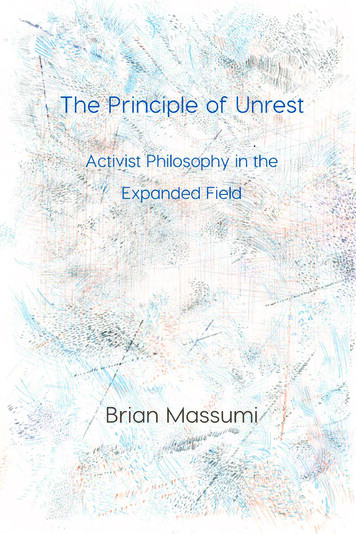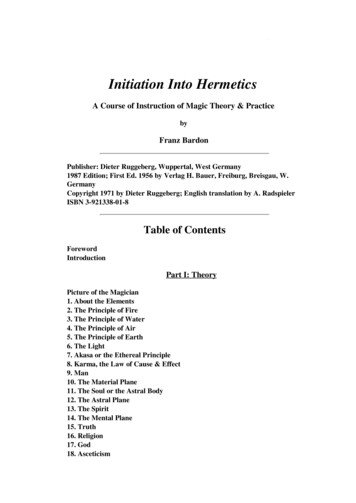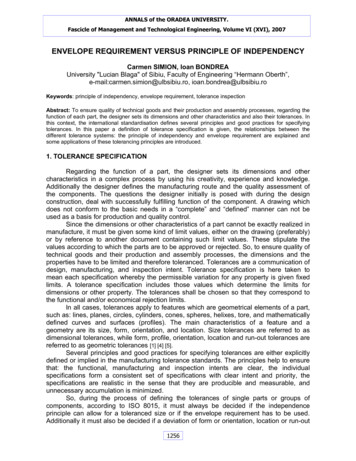
Transcription
The Principle of UnrestActivist Philosophy in theExpanded FieldBrian Massumi
The Principle of UnrestActivist Philosophy in the Expanded Field
ImmediationsSeries Editor: SenseLab“Philosophy begins in wonder. And, at the end, when philosophicthought has done its best, the wonder remains”– A.N. WhiteheadThe aim of the Immediations book series is to prolong the wonder sustainingphilosophic thought into transdisciplinary encounters. Its premise is that conceptsare for the enacting: they must be experienced. Thought is lived, else it expires.It is most intensely lived at the crossroads of practices, and in the in-between ofindividuals and their singular endeavors: enlivened in the weave of a relationalfabric. Co-composition.“The smile spreads over the face, as the face fits itself onto the smile”– A. N. WhiteheadWhich practices enter into co-composition will be left an open question, to beanswered by the Series authors. Art practice, aesthetic theory, political theory,movement practice, media theory, maker culture, science studies, architecture,philosophy the range is free. We invite you to roam it.
The Principle of UnrestActivist Philosophy in the Expanded FieldBrian MassumiOPEN HUMANITIES PRESSLondon 2017
First edition published by Open Humanities Press 2017Copyright 2017 Brian MassumiThis is an open access book, licensed under Creative Commons By AttributionShare Alike license. Under this license, authors allow anyone to download, reuse,reprint, modify, distribute, and/or copy their work so long as the authors andsource are cited and resulting derivative works are licensed under the same orsimilar license. No permission is required from the authors or the publisher.Statutory fair use and other rights are in no way affected by the above. Readmore about the license at creativecommons.org/licenses/by-sa/4.0Chapter 1 originally appeared in Krystian Woznicki and Brian Massumi,After the Planes: A Dialogue About Movement, Perception and Politics (Berlin:Diamondpapers, 2017), 77-178. It is reprinted here with revisions.Chapter 2 originally appeared as a booklet accompanying the DVD PerformanceDialogues 3 – Brian Massumi, filmed interview directed by Adrian Heathfield andHugo Glendinning as part of the “Performance Matters” project (Goldsmith’sUniversity/University of London/University of Roehampton/Live ArtDevelopment Agency/UK Arts & Humanities Research Council). 72 min.Chapter 3 originally appeared in Inflexions: A Journal for Research-Creation,“Radical Pedagogies” special issue, 8 (2015): 59-88. It is reprinted here withminor revisions.Cover Illustration 2017 Leslie PlumbCover Design by Leslie PlumbPrint ISBN 978-1-78542-044-3PDF ISBN 978-1-78542-045-0Freely available online -principle-of-unrestOPEN HUMANITIES PRESSOpen Humanities Press is an international, scholar-led open access publishingcollective whose mission is to make leading works of contemporary criticalthought freely available worldwide. More at http://openhumanitiespress.org
Contents1.Capital Moves 72.Movements of Thought 3.Collective Expression: A Radical Pragmatics 111Works Cited 14572
1Capital MovesInterview with Brian Massumiby Krystian WoznickiKrystian Woznicki: Somehow our world works best wheneverything (people, data, goods, money, etc.) remains in motion.What is this contemporary co-motion all about? In whichparticular sense is the social, economic and political frameworkfor such a world conditioned by the global expansion ofneoliberal capitalism?Brian Massumi: The world has always been in movement. Thestudy of human prehistory is currently being rewritten in lightof new realizations about the rapidity of the movements thatbrought our ancestors out of Africa and across Europe andAsia, and about the complexity of the migrations, which, it isnow realized, included movements of return among all threecontinents. There is movement everywhere, from as far backas we can see, and nowhere is it linear. There is a restlessnessin human history that constantly tangles the lines, so muchso as to call into the question the integrity of the species.Interbreeding between modern humans and other humanspecies, Neanderthals, Denisovans, and at least one other whoseexistence is at only hinted at, has contributed to our genome,
8Chapter 1and that contribution is now being tied to specific physiologicaland phenotypic characteristics of human populations.This may seem a bit off-topic, but it brings up some crucialpoints. The first is that there is a principle of unrest thattraverses human history. It does so in so entangling a way thatit calls into question notions of species integrity, let alone racialpurity, and fundamentally challenges the concept of identityas something stable that precedes movement and mixing. Itchallenges us to rethink movement, in order to think differentlyabout those issues, among many others.We normally think of movement as simple displacement:a change in location. What is in movement is thought of asremaining fundamentally what it was, retaining its identity acrossthe displacement. But as the human entered into entanglementsas it moved through history, it underwent changes in its verynature. It underwent qualitative change. Displacement is just thevisible trail of qualitative changes in nature. Displacement is notjust a shift of place. It’s the index of a becoming: movement notjust from one spatial location to another, but from one naturechanging entanglement to another. It’s always a question oftransformation – transformation in relation.In the movement of relational transformation, the very definitionof what moves changes. Identity is ceaselessly overcome invariation. Should we say, then, that the human has always beenon the move throughout its history? Or is it more accurate tosay that a movement of relational transformation has movedthrough the human? If so, when did that movement of relationaltransformation begin? It is clear that the “principle of unrest”predates the human – or rather this continuing process ofhominization – and runs the full length of evolution, from thebeginnings of life. From this perspective, the human is a carrierof a movement of relational transformation, one that swept it up,and sweeps through it.
Capital Moves9KW: Talking about human history and human life in that wayfeels intuitively right to me. Facing the environment or lookingat one’s body one somehow knows that everything is in flux –without always being able to actually grasp this. That is also whyI personally enjoy reading deconstruction or your philosophicalwriting: You experience the sense of the world as process. But tocome back to my initial question: How does movement play outin capitalism?BM: Capitalism may well be the figure in which the movement Iwas just describing actually exceeds the human. The neoliberalmoment might be thought of as a vector of becoming comingout the far side of our humanity. It is the moment when marketmechanisms declared their autonomy, and the economy becamea regime of power in its own right. Governments, let aloneindividual actors, feel they have no choice but to conform tothe operating conditions it sets for them. The cutting edge ofcapitalism is in the financial markets, which have evolved formsof abstract capital so abstruse, contingent, and objectivelyundecidable that it is impossible to get an effective grip on them.They run according to their own process, and sometimes runaway with themselves, periodically crashing and burning. Thefinancialized economy is beyond the human pale: beyond fullhuman comprehension and beyond effective human control. Itis a self-driving machine, operating more and more abstractly,with no one in particular at the steering wheel. It was createdby the human, but not in its own image, emerging rather as amonstrous offspring that turns back to engulf its maker anddrive away with it.This is what Deleuze and Guattari in A Thousand Plateausdescribes in terms of “machinic enslavement,” prescientlydescribing the neoliberal moment before the fact (1987: 466473). They speak of the role of the nation-state changing. Thestate, they say, now functions as a “model of realization” forglobal capital, or what Guattari liked to call “worldwide integrated
10Chapter 1capitalism.” What they mean is that nation-states can modulatethe way the capitalist process falls on their territory, using theirborders as a kind of refractive lens, but they cannot be themaster of it. At best, they can create zones of relative stability,precariously sheltering their national territory from the worsteffects of the “creative destruction” of capital’s transformationalmovements, and redistributing those effects elsewhere. Thesituation in Greece vis-à-vis Germany and the other more stableeconomies at the core of the European Union is a case in point.The Greek state is rendered powerless and forced to acceptconditions deeply unacceptable to its population in the name ofthe core stability of the integrated European market.But this relation is just an internalization within Europe of theimbalance of capitalist power that has defined the dehumanizingrelation between the “developed world” and the “developingworld” for a long time. The state’s humanistic aspirations (socialwelfare, universal rights, and respect of the person) have becomesubordinate to the economic “realities.” Philosophy declared thehumanism supposedly embodied in the modern state dead manydecades ago. But it jumped the gun. It is the neoliberal-capitalistrealism that pulled the trigger. Bill Clinton’s 1992 presidentialcampaign slogan said it pithily: “it’s the economy, stupid.”Twenty-five years on, it still is. It has gotten to the point that itseems that many people have concluded that the only possibleway around it is actually to install stupidity at the head of thestate (candidate Donald Trump’s belief that as president he couldman-handle the economy with not-so-invisible little hands hadpundits’ heads swimming).KW: There is a lot of talk about how the continuous accelerationof the movement of people, data, goods and money seemsto further enlarge the crisis of liberal democracy. A variety ofobservers have pointed out that democractic apparatuses arenot up to dealing with the speed of contemporary movements.What is your take on this?
Capital Moves11BM: The speed of contemporary movements is indeed a factor,but speed is not adequate as a diagnostic tool. It is inadequate inlight of what I was just saying about displacement being the indexof a movement of qualitative change. Speed and acceleration arebasically displacement concepts. They are quantitative notionsreferring to the rate of displacement. How many things anddifferent kinds of things are catapulted into circulation by capital,and how fast they turn over, is the tip of the iceberg. The bulkof the issue is that there has been a qualitative change in howcapitalism’s movements move.KW: What is this qualitative change about?BM: Capitalism no longer just assembles its products fromraw materials and fabricated components, and then launchesthem into circulation. That scenario assumes a predesignedproduct, and a meaningful separation between the realm ofproduction and the realm of circulation. Today, those realmshave largely collapsed into each other. Contemporary capitalismis increasingly concerned with setting in place the conditionsfor its products to emerge. They are not only made to emerge,but this happens as a by-product of circulation itself. Thereare many ways this happens. Examples are the feedback loopsthat have formed between crowdsourcing and the data-miningof internet, cell phone traffic, and credit-card use on the onehand, and product-development and marketing on the other.The network becomes a matrix of emergence for productsthat do not preexist, but take shape in and through networkedcirculation. In the ebb and flow, marketing potentials appearlike waves cresting on a sea of movements. These are skimmedoff, “mined,” then concretized as new products to be sold forprofit. You could look at the profit generated as embodying a“surplus-value of flow”: a yield of added value emerging fromthe complexity of movements under way, directly as a functionof them. Philosophically speaking, capitalism has learned tomotorize itself immanently to its own movements.
12Chapter 1The epitome of surplus-value of flow is the way the financialmarkets operate. At that level, surplus-value is produced byleveraging movements of capital, by gaming turnover, byplaying the timing of transactions, by second-guessing thetrends, without even the need for a concretized product toemerge, but rather purely through abstract, second-orderproducts like derivatives and credit default swaps. It is towardthis short-circuiting of production that the center of gravityof the economy has moved, as if in search of a soul: the spiritof capitalism endeavoring to free itself from the body ofproduction. Capital, self-abstracting. The value of the financialsector in the developed economies is now many times greaterthan the manufacturing sector. Even if the self-abstracting cannever be complete, and the articulation of the financial marketsto the so-called “real” economy cannot be eliminated, it is highlysignificant that the balance has shifted and that the effort ofcapital to levitate itself from the sphere of concrete productionhas taken on the piloting role.Another prominent, very different, way in which capitalismhas learned to valorize matrices of emergence is throughbiotechnology. Biotechnology, for its part, doesn’t abstractthe body away. It abstracts it into existence. It descends to theemergent material level of life, the gene, in order to manipulatethe potentials of life’s rearising. It operates on an infra-corporeallevel. Capital, taking body emergently. The infra-corporeal levelis a level that is “immanent” to existence: the well-spring fromwhich it emerges like an artesian well feeding the many streamsof life. It is the level of potential.KW: What do you mean by infra?BM: “Infra-” is a prefix I like to use to refer to the immanentlevel at which potentials of emergence are found. As my twoexamples indicate, the immanence of the infra-, and the mannerin which it is accessed and to what effect, is highly variable.
Capital Moves13An extraction of surplus-value from an infra-level is not amanufacture. Financial surplus-value comes from capital’sbecoming self-abstracting as a function of its own flow, hoistingitself on its own soulful petards into another realm of its being.Biotechnological reembodiments, for their part, are more grownthan manufactured – they are less made than made to take form,by manipulating how potentials come to express themselves. Onthe infra-level what is at issue is a veritable becoming, a bringinginto determinate existence of something prefigured only on therun, in the upswell of as-yet unformed potential. Modulating ormanipulating what comes of this level constitutes an extremeform of power: the power to bring to be; the power to makebecome; the power to harness qualitative transformation. Icall it ontopower (“onto” from “ontogenesis,” or the process ofbeing’s becoming).KW: You recently published two books which develop theconcept: Ontopower (2015) and The Power at the End of theEconomy (2014a). I wonder how this concept of power plays out inour discussion about movement.BM: I said earlier that the economy has become a regime ofpower in its own right. What I meant is that the capitalist processhas made itself an ontopower. This has far-reaching implicationsfor liberal democracy when you consider that according totheorists of neoliberalism, its most astute proponents as wellas its critics, neoliberalism does not just produce objects, butalso its own subjects. Foucault called the neoliberal subject the“subject of interest,” emphasizing that its form is homologous tothat of the enterprise. The founding theorists of neoliberalismcalled this enterprise-subject “human capital.” In The Power atthe End of the Economy and Ontopower, I try to look at some ofthe consequences of the way in which capitalism’s ontopowerextends to the production of the very capitalized individuals, thecapital life-forms, that populate its field. The fact that capitalismhas found ways to productively access matrices of emergence
14Chapter 1means that it now increasingly functions at the infra-individuallevel wherever capital flows – which is everywhere. Capital seepsdown to the affective level of felt potential, before life potentialshave concretized in a determinate form of life, where life isas-yet emergent.This level is stirring with micromovements. I call these formative,but not yet fully formed movements “bare activity.” Withrespect to the infra-human, these are ebbs and flows of desire,tendency, fear, hope, self-interest, sympathy, tensings for actionand easings into relation. It is as easy as click-bait to modulatethat ebb and flow in order to orient its taking-determinateform. Facebook demonstrated this with its infamous informalexperiment in modulating people’s moods and online behaviorby modulating the affective tenor of their Facebook feeds.Capitalism has learned to descend to the infra-level where theindividual is emergently divided among potential inflections of itsown self-formative movements. Deleuze coined a word for theneoliberal subject, taking this self-dividing, this “schizzing,” intoaccount: the “dividual” (Deleuze 1995).My hypothesis is that neoliberal capitalism directly couplesthis infra-individual level with the transindividual level. Itenergizes itself with feedback effects between the infraand transindividual levels in a way that largely bypasses theintermediate level of the supposedly self-contained individual.This intermediate level is that of the social or moral person:the figure of the citizen, as subject of right, and the subject ofrational interest. This level of the person, at which we like to thinkwe function, is reduced to a hinge mechanism through whichthe infra- and the trans- communicate: a miniaturized “model ofrealization” of global capital, zoomed down to fit the contoursof the human body (or rather, the pattern of whole-bodymovements indexing the flow of a quantum of human-capitalbecoming). The transindividual level is, at its widest horizon, theintegrated worldwide network of qualitatively transformational
Capital Moves15movements whose complexity and contingency escapes notonly individual human control, but mastery by any individualnation-state.KW: If the figure of the citizen is somehow suspended incapitalism, what does that imply for models of democracy?BM: There is a fundamental misfit between the multi-scaleregime of ontopower I just described and liberal democracy.Liberal democracy is ostensibly predicated on the personalsanctity of the individual subject of right, the citizen safelyenwrapped within the sovereign sanctity of the individual state.Liberal democracy only knows how to work across those twoscales of individuality, the fully formed citizen and the sovereignstate (neither of which is what it purports to be any longer). Itsbridging strategy is the mechanism of representation. It is thismechanism that has broken down.Representation is dead – if it was ever really alive. Who todayfeels truly represented by their elected government? Witnessthe exodus from the established parties throughout the world,most vividly illustrated by the rise of the populist “independent”voter in the United States and elsewhere who disavows anyparty allegiance that would inscribe them in the institutionalized,normative functionings of their supposedly representativegovernmental system. The result is a simultaneous leakage fromthe left and the right, producing an increasing polarization. Themechanism of representation is obsolete. It assumes a stableidentity on both scales: a government that mirrors who itscitizens are, and citizens who embody the identity of the state,in a mutually structuring embrace. The prevailing conditions,however, are of continual qualitative change, ceaselesstransformational relational movements – as far from a stablestructure as you can get. The structural embrace has been sweptthrough by becoming, transversed by flows that are increasinglyuncontrolled by anyone or any one institution in particular.
16Chapter 1As a result, the purportedly rational intercourse liberaldemocracy assumes as the necessary condition for its structureof representation has been swamped by affect stirred upby the structurally disavowed instability. Affective tides ebband flow. In their upswell they prefigure emergent, far-fromequilibrium follow-on movements whose direction is increasinglyunpredictable. Representation lies among the flotsam andjetsam like a weather-beaten plastic bottle.KW: Could you give an example?BM: Look at the Brexit vote. UK voters voted to “take back theircountry” from the supra-national EU, but the complexity of thesituation actually means that what they may get is their country’sbreaking apart, with Scotland now reconsidering its own recentvote to stay in the union. They voted to represent their perceivedpersonal and national interests, only to be taken aback by theresult, leading to a widespread expression of hand-wringingcontrition the very next day, out of sudden doubt that theirrepresentation of their interests represented their interests. Aresounding decision of indecision.The whole thing was an exercise in the avoidance of the politicalcrux of the matter: that non-representative forms of democracyneed to be invented, at the interpersonal, national, and supranational levels – or better, transversal to them all, in a newkind of infra-trans feedback system yet to be invented. Playingthe identity card and the associated discourse of particularistinterest, on whatever level, leads nowhere. The plastic bottle ofrepresentation, half-full of polluted water, is running on empty.The dividual rules – one way or another. The dividual is theindividual divided among itself. This considerably complicatesthe calculus of interests, which become undecidable withinthe structure of representation. Perhaps, if new practices areinvented for it, rather than in denial of it as is presently the case,
Capital Moves17the dividual can become the seat of ontopowers counter tocapital: counter-ontopowers.KW: Where to start?BM: It is important, in thinking about what democracy couldbecome, to try to theorize this becoming integrally-affective ofpolitics and the role of the dividual. This has to be done withoutgiving credence to the idea that rationality and affectivity areopposites (rather, deconstructing that opposition). It is critical tobe able to think about and experiment with the ways in whichaffectively-based politics can give rise to radically inclusive formsof direct democracy.KW: The term direct democracy is often used to referto referenda.BM: Yes, but as Brexit has shown once again, in the networked,affectively energized political environment, the referendum isbut a caricature of it. Prefigurative glimpses of what it could behave been seen in the spontaneously self-organizing movementsof the 2010s, from Occupy and the indignados forward throughevents like 2016’s Nuit Debout, and their power of contagionacross identity lines. Nothing like a definitive model hasemerged. But something has been stirring. The politics-to-comewill likely have no definitive model, by dint of transformativemovement. No one model, but many relational matrices, inresonance and interference. That prospect is uncertain, evenunsettling, but the alternative is downright frightening: a returnof a kind of affective politics more akin to the one whose ravageswe know only all too well from the history of the twentiethcentury – the radically exclusive anti-democratic movements offascism. These also are stirring, in the same cauldron of bareactivity, immanent to the same field of complexity.KW: How could we reimagine and rebuild democracies byunderstanding movement better?
18Chapter 1BM: As a preliminary to that question, it is important to thinkvery hard about the historical conjuncture we have arrived at. If avector of becoming has swept through and come out the far sideof the human adventure in the form of the neoliberal-capitalistmachinery of ontopower, then the label of the Anthropocene todesignate the age we are entering is off the mark. I find JasonW. Moore’s term the “Capitalocene” (Moore 2015) a much betterstarting point, because this is the age in which the movementof the capitalist process through the human outstrips “man,”precisely by making the effects of “his” activity ubiquitous, inever more complicated feedback effects between levels thatescape his control, to the ultimate detriment of his own lifeenvironment and, potentially, his very survival.To a certain extent, this dovetails with the discourse of whathas come to be known as accelerationism. But we have to becareful. It is necessary to work through the issues guided by anunderstanding of movement as qualitative transformation. Thepremise of accelerationism is that capitalism’s natural tendencyis to speed things up. Since the mobilization of capital is nowubiquitous, the only way out is to encourage it to speed upits own speeding up ever more. In catastrophist versions, theacceleration will reach a point where the capitalist economy canno longer catch its own tail in surplus-value of flow, and it falls ina heap – the crisis to end all capitalist crises. All of this is couchedin quantitative terms of speed.KW: Yes, we touched upon this issue already.BM: It’s crucial to return to that point here, in order to accountfor the possibility – I would call it a certainty – that in the fieldof emergence plied by the movements of capitalism thereare emergent potentials for qualitatively different modes ofexistence that are stultified because –if they were allowed totake fully formed expression, if the budding tendencies theyprefigure were to deploy and express themselves to their fullest
Capital Moves19power – they would move in directions beyond capitalism’s orbit.In other words, on the infra-level of potential there are germinalstirrings of counter-powers of emergence. These are ontopowersimmanent to capitalism’s processual field, but as-yet uncapturedby its logic. When movements suddenly and inexplicably erupt,as happened in 2010-2011 and sporadically since, in one countryafter another, it is these potentials germinating and coming toa paroxysmal expression that suddenly calls everything intoquestion, at times extending to capitalism itself, only to fizzle justas quickly they came. If we honed ways of understanding thesecountertendencies, perceiving them in germ, curating the tracesof their passing in a way that makes them reactivatable, thenperhaps we could coax them into taking more enduring form– or at least iterating more often, with more transformationalrelational overlaps, and as a result greater potential forcontagion. Perhaps it is possible to extract counter-capitalistsurplus-values of movement.If this is possible, it is only by acting directly in the register ofaffect. No amount of ideological analysis or persuasion willdo the trick, because programmatic politics is as implicated instructures of representation and identity as liberal democracyis, although from a different angle (for example, in the guise ofthe “will of the people” as spear-headed by a vanguard, explicitlyor in the implicit form of a technocratic elite). The countertendencies I’m talking about are just as moving, just as emergentand, ultimately, just as self-driving as the machine of capitalismitself – only with a different, non-monetary, directly qualitativesense of value. That is a sense of the value of movements,events, relations, in and for themselves, a sense of aliveness, thesense of intensity that comes with the experience of potential.These unmonetizable surplus-values of movement feedbackinto themselves, in their own currency of experienced potential,sketching alter-economies of transformational relation. They aretendentially anti-capitalist counter-ontopowers immanent to thecapitalist field.
20Chapter 1KW: I am not sure I can follow your interest in value.BM: The call to focus on the question of the qualitative inmovement is a proposal to return to the question of value,radically rethought outside programmatic politics or normativeethics. To concede the question of value to capitalism, moralism,or conformism is to lose the battle before it begins. Anydemocracy-to-come will arrive as a collective embodiment ofemergent intensities of experience whose living-out is its ownvalue, immanent to that live event, before they are encasted inany institutional armature, and with the tendency to push acrossand overspill any regularizing or regulatory incorporation, in aperpetual cycle of stabilizing capture and revivifying escape.This is value not unlike the way in painting we speak of the valueof a color. This is where I want to take my work next: towarda rethinking of politics based on a chromatic theory of value(Massumi 2017). The basis for a chromatic politics can be foundin the work of Whitehead and Ruyer, and in a unique formulationin the work of Fred Moten (although Moten would have seriousreservations about rehabilitating the term value).KW: Activism and emancipatory politics in general are oftensearching for the outside to capitalism. The way you linkedcapitalism and movement, the question arises: Is there anoutside to movement? In a world that is centered aroundmovement, is even non-movement a type of movement?BM: No, there is no outside to movement. As Erin Manning pointsout in her book Relationscapes (2009), even stillness is composedof movements. Standing still is a dynamic balance achievedthrough liminally perceptible micromovements of muscles andattention. In physic
welfare, universal rights, and respect of the person) have become subordinate to the economic "realities." Philosophy declared the humanism supposedly embodied in the modern state dead many decades ago. But it jumped the gun. It is the neoliberal-capitalist realism that pulled the trigger. Bill Clinton's 1992 presidential










